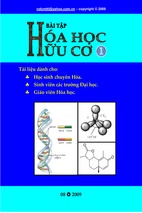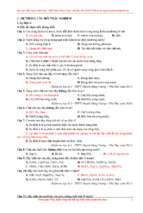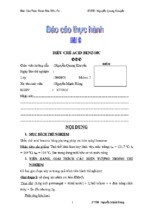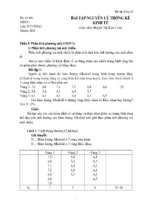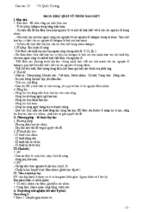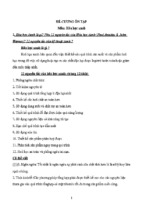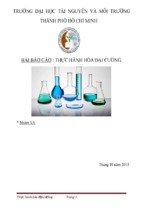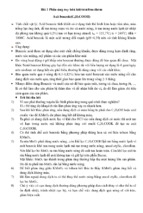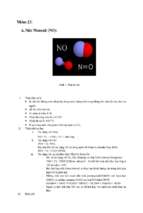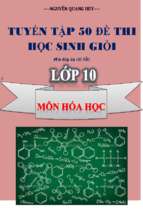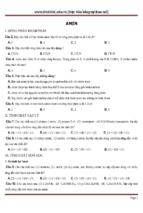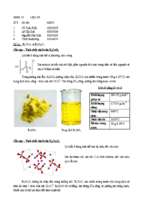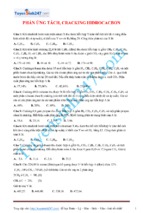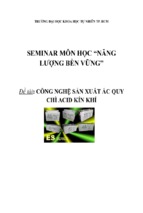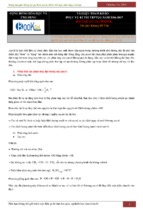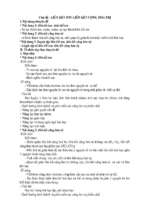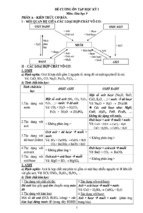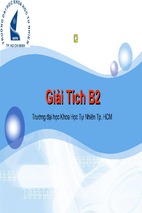Organic Chemistry As a Second Language, 3e First Semester Topics - David Klein
This page intentionally left blank
ORGANIC CHEMISTRY
AS A SECOND
LANGUAGE, 3e
First Semester Topics
DAVID KLEIN
Johns Hopkins University
JOHN WILEY & SONS, INC.
Associate Publisher
Editorial Assistant
Senior Production Editor
Marketing Manager
Senior Cover Designer
Petra Recter
Lauren Stauber
Elizabeth Swain
Kristine Ruff
Wendy Lai
Cover Credits: Background: ©William Hopkins/iStockphoto; test tube: Untitled X-Ray/Nick
Veasey/Getty Images, Inc.; bicycle: Igor Shikov/Shutterstock.
This book was typeset by Prepare and printed and bound by Courier Westford. The cover was
printed by Courier Westford.
This book is printed on acid free paper. oo
Founded in 1807, John Wiley & Sons, Inc. has been a valued source of knowledge and understanding for more than 200 years, helping people around the world meet their needs and
fulfill their aspirations. Our company is built on a foundation of principles that include
responsibility to the communities we serve and where we live and work. In 2008, we
launched a Corporate Citizenship Initiative, a global effort to address the environmental,
social, economic, and ethical challenges we face in our business. Among the issues we are
addressing are carbon impact, paper specifications and procurement, ethical conduct within
our business and among our vendors, and community and charitable support. For more
information, please visit our website: www.wiley.com/go/citizenship.
Copyright © 2012, 2006, 2005 John Wiley & Sons, Inc. All rights reserved. No part of this
publication may be reproduced, stored in a retrieval system or transmitted in any form or by
any means, electronic, mechanical, photocopying, recording, scanning or otherwise, except
as permitted under Sections 107 or 108 of the 1976 United States Copyright Act, without
either the prior written permission of the Publisher, or authorization through payment of
the appropriate per-copy fee to the Copyright Clearance Center, Inc. 222 Rosewood Drive,
Danvers, MA 01923, website www.copyright.com. Requests to the Publisher for permission
should be addressed to the Permissions Department, John Wiley & Sons, Inc., 111 River
Street, Hoboken, NJ 07030-5774, (201)748-6011, fax (201)748-6008, website
http://www.wiley.com/go/permissions.
Evaluation copies are provided to qualified academics and professionals for review purposes
only, for use in their courses during the next academic year. These copies are licensed and
may not be sold or transferred to a third party. Upon completion of the review period, please
return the evaluation copy to Wiley. Return instructions and a free of charge return mailing
label are available at www.wiley.com/go/returnlabel. If you have chosen to adopt this textbook for use in your course, please accept this book as your complimentary desk copy.
Outside of the United States, please contact your local sales representative.
ISBN 978-1-118-01040-2
Printed in the United States of America
10 9 8 7 6 5 4 3 2 1
INTRODUCTION
IS ORGANIC CHEMISTRY REALLY ALL
ABOUT MEMORIZATION?
Is organic chemistry really as tough as everyone says it is? The answer is yes and no.
Yes, because you will spend more time on organic chemistry than you would spend
in a course on underwater basket weaving. And no, because those who say it’s so
tough have studied inefficiently. Ask around, and you will find that most students
think of organic chemistry as a memorization game. This is not true! Former organic
chemistry students perpetuate the false rumor that organic chemistry is the toughest
class on campus, because it makes them feel better about the poor grades that they
received.
If it’s not about memorizing, then what is it? To answer this question, let’s
compare organic chemistry to a movie. Picture in your mind a movie where the plot
changes every second. If you’re in a movie theatre watching a movie like that, you
can’t leave even for a second because you would miss something important to the
plot. So you try your hardest to wait until the movie is over before going to the bathroom. Sound familiar?
Organic chemistry is very much the same. It is one long story, and the
story actually makes sense if you pay attention. The plot constantly develops, and
everything ties into the plot. If your attention wanders for too long, you could
easily get lost.
OK, so it’s a long movie. But don’t I need to memorize it? Of course, there are
some things you need to memorize. You need to know some important terminology
and some other concepts that require a bit of memorization, but the amount of pure
memorization is not that large. If I were to give you a list of 100 numbers, and I
asked you to memorize them all for an exam, you would probably be very upset by
this. But at the same time, you can probably tell me at least 10 telephone numbers
off the top of your head. Each one of those has 10 digits (including the area codes).
You never sat down to memorize all 10 telephone numbers. Rather, over time you
slowly became accustomed to dialing those numbers until the point that you knew
them. Let’s see how this works in our movie analogy.
You probably know at least one person who has seen one movie more than five
times and can quote every line by heart. How can this person do that? It’s not because he or she tried to memorize the movie. The first time you watch a movie, you
learn the plot. After the second time, you understand why individual scenes are necessary to develop the plot. After the third time, you understand why the dialogue was
necessary to develop each scene. After the fourth time, you are quoting many of the
iii
iv
INTRODUCTION
lines by heart. Never at any time did you make an effort to memorize the lines. You
know them because they make sense in the grand scheme of the plot. If I were to give
you a screenplay for a movie and ask you to memorize as much as you can in 10
hours, you would probably not get very far into it. If, instead, I put you in a room for
10 hours and played the same movie over again five times, you would know most of
the movie by heart, without even trying. You would know everyone’s names, the
order of the scenes, much of the dialogue, and so on.
Organic chemistry is exactly the same. It’s not about memorization. It’s all
about making sense of the plot, the scenes, and the individual concepts that make up
our story. Of course you will need to remember all of the terminology, but with
enough practice, the terminology will become second nature to you. So here’s a brief
preview of the plot.
THE PLOT
The first half of our story builds up to reactions, and we learn about the characteristics of molecules that help us understand reactions. We begin by looking at atoms,
the building blocks of molecules, and what happens when they combine to form
bonds. We focus on special bonds between certain atoms, and we see how the nature of bonds can affect the shape and stability of molecules. At this point, we need
a vocabulary to start talking about molecules, so we learn how to draw and name
molecules. We see how molecules move around in space, and we explore the relationships between similar types of molecules. At this point, we know the important
characteristics of molecules, and we are ready to use our knowledge to explore
reactions.
Reactions take up the rest of the course, and they are typically broken down
into chapters based on categories. Within each of these chapters, there is actually a
subplot that fits into the grand story.
HOW TO USE THIS BOOK
This book will help you study more efficiently so that you can avoid wasting countless hours. It will point out the major scenes in the plot of organic chemistry. The
book will review the critical principles and explain why they are relevant to the rest
of the course. In each section, you will be given the tools to better understand your
textbook and lectures, as well as plenty of opportunities to practice the key skills that
you will need to solve problems on exams. In other words, you will learn the language of organic chemistry. This book cannot replace your textbook, your lectures,
or other forms of studying. This book is not the Cliff Notes of Organic Chemistry. It
focuses on the basic concepts that will empower you to do well if you go to lectures
and study in addition to using this book. To best use this book, you need to know
how to study in this course.
INTRODUCTION
v
HOW TO STUDY
There are two separate aspects to this course:
1. Understanding principles
2. Solving problems
Although these two aspects are completely different, instructors will typically gauge
your understanding of the principles by testing your ability to solve problems. So
you must master both aspects of the course. The principles are in your lecture notes,
but you must discover how to solve problems. Most students have a difficult time
with this task. In this book, we explore some step-by-step processes for analyzing
problems. There is a very simple habit that you must form immediately: learn to ask
the right questions.
If you go to a doctor with a pain in your stomach, you will get a series of questions: How long have you had the pain? Where is the pain? Does it come and go, or
is it constant? What was the last thing you ate? and so on. The doctor is doing two
very important and very different things. First, he has learned the right questions to
ask. Next, he applies the knowledge he has together with the information he has
gleaned to arrive at the proper diagnosis. Notice that the first step is asking the right
questions.
Let’s imagine that you want to sue McDonald’s because you spilled hot coffee
in your lap. You go to an attorney and she asks you a series of questions that enable
her to apply her knowledge to your case. Once again, the first step is asking questions.
In fact, in any profession or trade, the first step of diagnosing a problem is always to ask questions. Let’s say you are trying to decide if you really want to be a
doctor. There are some tough, penetrating questions that you should be asking yourself. It all boils down to learning how to ask the right questions.
The same is true with solving problems in this course. Unfortunately, you are
expected to learn how to do this on your own. In this book, we will look at some
common types of problems and we will see what questions you should be asking in
those circumstances. More importantly, we will also be developing skills that will
allow you to figure out what questions you should be asking for a problem that you
have never seen before.
Many students freak out on exams when they see a problem that they can’t do.
If you could hear what was going on in their minds, it would sound something like
this: “I can’t do it . . . I’m gonna flunk.” These thoughts are counterproductive and a
waste of precious time. Remember that when all else fails, there is always one question that you can ask yourself: “What questions should I be asking right now?”
The only way to truly master problem-solving is to practice problems every
day, consistently. You will never learn how to solve problems by just reading a book.
You must try, and fail, and try again. You must learn from your mistakes. You must
get frustrated when you can’t solve a problem. That’s the learning process. Whenever
you encounter an exercise in this book, pick up a pencil and work on it. Don’t skip
over the problems! They are designed to foster skills necessary for problem-solving.
vi
INTRODUCTION
The worst thing you can do is to read the solutions and think that you now
know how to solve problems. It doesn’t work that way. If you want an A, you will
need to sweat a little (no pain, no gain). And that doesn’t mean that you should spend
day and night memorizing. Students who focus on memorizing will experience the
pain, but few of them will get an A.
The simple formula: Review the principles until you understand how each of
them fits into the plot; then focus all of your remaining time on solving problems.
Don’t worry. The course is not that bad if you approach it with the right attitude. This
book will act as a road map for your studying efforts.
CONTENTS
CHAPTER 1
1.1
1.2
1.3
1.4
1.5
1.6
BOND-LINE DRAWINGS
1
How to Read Bond-Line Drawings 1
How to Draw Bond-Line Drawings 5
Mistakes to Avoid 7
More Exercises 7
Identifying Formal Charges 10
Finding Lone Pairs That Are Not Drawn
CHAPTER 2
RESONANCE
14
20
2.1
2.2
2.3
2.4
2.5
2.6
2.7
What Is Resonance? 20
Curved Arrows: The Tools for Drawing Resonance Structures 21
The Two Commandments 24
Drawing Good Arrows 27
Formal Charges in Resonance Structures 29
Drawing Resonance Structures—Step by Step 33
Drawing Resonance Structures—By Recognizing Patterns 38
A Lone Pair Next to a Pi Bond 38
A Lone Pair Next to a Positive Charge 41
A Pi Bond Next to a Positive Charge 43
A Pi Bond Between Two Atoms, Where One of Those Atoms Is
Electronegative (N, O, etc.) 44
Pi Bonds Going All the Way Around a Ring 45
2.8 Assessing the Relative Importance of Resonance Structures 47
CHAPTER 3
3.1
3.2
3.3
3.4
3.5
3.6
3.7
3.8
ACID–BASE REACTIONS
53
Factor 1—What Atom Is the Charge on? 54
Factor 2—Resonance 57
Factor 3—Induction 61
Factor 4—Orbitals 64
Ranking the Four Factors 65
Quantitative Measurement (pKa values) 69
Predicting the Position of Equilibrium 70
Showing a Mechanism 71
vii
viii
CONTENTS
CHAPTER 4
GEOMETRY
74
4.1 Orbitals and Hybridization States
4.2 Geometry 78
4.3 Lone Pairs 81
CHAPTER 5
5.1
5.2
5.3
5.4
5.5
5.6
5.7
5.8
CONFORMATIONS
103
104
How to Draw a Newman Projection 105
Ranking the Stability of Newman Projections 109
Drawing Chair Conformations 113
Placing Groups on the Chair 116
Ring Flipping 121
Comparing the Stability of Chairs 127
Don’t Be Confused by the Nomenclature 131
CHAPTER 7
7.1
7.2
7.3
7.4
7.5
7.6
7.7
7.8
83
Functional Group 84
Unsaturation 86
Naming the Parent Chain 88
Naming Substituents 90
Stereoisomerism 94
Numbering 97
Common Names 102
Going from a Name to a Structure
CHAPTER 6
6.1
6.2
6.3
6.4
6.5
6.6
6.7
NOMENCLATURE
74
CONFIGURATIONS
132
Locating Stereocenters 133
Determining the Configuration of a Stereocenter
Nomenclature 144
Drawing Enantiomers 149
Diastereomers 154
Meso Compounds 155
Drawing Fischer Projections 158
Optical Activity 163
CHAPTER 8
MECHANISMS
8.1 Curved Arrows 166
8.2 Arrow Pushing 171
8.3 Drawing Intermediates
165
173
136
CONTENTS
8.4
8.5
8.6
8.7
8.8
Nucleophiles and Electrophiles 176
Bases Versus Nucleophiles 177
The Regiochemistry Is Contained Within the Mechanism
The Stereochemistry Is Contained Within the Mechanism
A List of Mechanisms 188
CHAPTER 9
9.1
9.2
9.3
9.4
9.5
9.6
9.7
SUBSTITUTION REACTIONS
ELIMINATION REACTIONS
226
10.1 The E2 Mechanism 226
10.2 The Regiochemical Outcome of an E2 Reaction
10.3 The Stereochemical Outcome of an E2 Reaction
10.4 The E1 Mechanism 232
10.5 The Regiochemical Outcome of an E1 Reaction
10.6 The Stereochemical Outcome of an E1 Reaction
10.7 Substitution vs. Elimination 234
10.8 Determining the Function of the Reagent 235
10.9 Identifying the Mechanism(s) 238
10.10 Predicting the Products 241
CHAPTER 11
ADDITION REACTIONS
183
209
The Mechanisms 209
Factor 1—The Electrophile (Substrate) 212
Factor 2—The Nucleophile 215
Factor 3—The Leaving Group 217
Factor 4—The Solvent 220
Using All Four Factors 223
Substitution Reactions Teach Us Some Important Lessons
CHAPTER 10
180
245
11.1 Terminology Describing Regiochemistry 245
11.2 Terminology Describing Stereochemistry 247
11.3 Adding H and H 256
11.4 Adding H and X, Markovnikov 259
11.5 Adding H and Br, Anti-Markovnikov 266
11.6 Adding H and OH, Markovnikov 271
11.7 Adding H and OH, Anti-Markovnikov 275
11.8 Synthesis Techniques 279
11.9 Adding Br and Br; Adding Br and OH 287
11.10 Adding OH and OH, Anti 293
11.11 Adding OH and OH, Syn 296
11.12 Oxidative Cleavage of an Alkene 298
227
229
233
234
224
ix
x
CONTENTS
CHAPTER 12
ALCOHOLS
302
12.1 Naming and Designating Alcohols 302
12.2 Predicting Solubility of Alcohols 303
12.3 Predicting Relative Acidity of Alcohols 306
12.4 Preparing Alcohols: A Review 309
12.5 Preparing Alcohols via Reduction 310
12.6 Preparing Alcohols via Grignard Reactions 317
12.7 Summary of Methods for Preparing Alcohols 322
12.8 Reactions of Alcohols: Substitution and Elimination
12.9 Reactions of Alcohols: Oxidation 327
12.10 Converting an Alcohol into an Ether 329
CHAPTER 13
13.1
13.2
13.3
13.4
SYNTHESIS
332
One-step Syntheses 333
Multistep Syntheses 345
Retrosynthetic Analysis 346
Creating Your Own Problems
Answer Key
Index 375
349
347
323
1
CHAPTER
BOND-LINE DRAWINGS
To do well in organic chemistry, you must first learn to interpret the drawings that
organic chemists use. When you see a drawing of a molecule, it is absolutely critical that you can read all of the information contained in that drawing. Without this
skill, it will be impossible to master even the most basic reactions and concepts.
Molecules can be drawn in many ways. For example, below are three different
ways of drawing the same molecule:
H
H
C
H
H
H
C
C
H
H
O
C
C
H
C
H
H
O
C
H
(CH3)2CHCH=CHCOCH3
H
Without a doubt, the last structure (bond-line drawing) is the quickest to draw, the
quickest to read, and the best way to communicate. Open to any page in the second half
of your textbook and you will find that every page is plastered with bond-line drawings.
Most students will gain a familiarity with these drawings over time, not realizing how
absolutely critical it is to be able to read these drawings fluently. This chapter will help
you develop your skills in reading these drawings quickly and fluently.
1.1 HOW TO READ BOND-LINE DRAWINGS
Bond-line drawings show the carbon skeleton (the connections of all the carbon
atoms that build up the backbone, or skeleton, of the molecule) with any functional
groups that are attached, such as – OH or – Br. Lines are drawn in a zigzag format,
where each corner or endpoint represents a carbon atom. For example, the following
compound has 7 carbon atoms:
It is a common mistake to forget that the ends of lines represent carbon atoms as
well. For example, the following molecule has six carbon atoms (make sure you can
count them):
1
2
CHAPTER 1 BOND-LINE DRAWINGS
Double bonds are shown with two lines, and triple bonds are shown with three lines:
When drawing triple bonds, be sure to draw them in a straight line rather than zigzag,
because triple bonds are linear (there will be more about this in the chapter on geometry). This can be quite confusing at first, because it can get hard to see just how
many carbon atoms are in a triple bond, so let’s make it clear:
is the same as
so this compound
has 6 carbon atoms
C
C
It is common to see a small gap on either side of a triple bond, like this:
is the same as
Both drawings above are commonly used, and you should train your eyes to see
triple bonds either way. Don’t let triple bonds confuse you. The two carbon atoms of
the triple bond and the two carbons connected to them are drawn in a straight line.
All other bonds are drawn as a zigzag:
H
H
H
H
H
C
C
C
C
H
H
H
H
is drawn like this:
H
BUT
H
H
C
H
H
C
C
C
is drawn like this:
H
H
EXERCISE 1.1 Count the number of carbon atoms in each of the following drawings:
O
The first compound has six carbon atoms, and the second compound has
five carbon atoms:
Answer
1
O
2
6
3
5
4
4
2
1
3
5
1.1 HOW TO READ BOND-LINE DRAWINGS
3
PROBLEMS Count the number of carbon atoms in each of the following drawings.
N
O
1.2 Answer:
1.3 Answer:
1.4 Answer:
1.5 Answer:
O
N
1.6 Answer:
O
1.7 Answer:
1.8 Answer:
1.9 Answer:
OH
O
1.10 Answer:
1.11 Answer:
Now that we know how to count carbon atoms, we must learn how to count
the hydrogen atoms in a bond-line drawing of a molecule. Most hydrogen atoms are
not shown, so bond-line drawings can be drawn very quickly. Hydrogen atoms connected to atoms other carbon (such as nitrogen or oxygen) must be drawn:
H
N
SH
OH
But hydrogen atoms connected to carbon are not drawn. Here is the rule for determining how many hydrogen atoms there are on each carbon atom: neutral carbon
atoms have a total of four bonds. In the following drawing, the highlighted carbon
atom is showing only two bonds:
We only see two bonds
connected to this carbon atom
Therefore, it is assumed that there are two more bonds to hydrogen atoms (to give a
total of four bonds). This is what allows us to avoid drawing the hydrogen atoms and
to save so much time when drawing molecules. It is assumed that the average person knows how to count to four, and therefore is capable of determining the number
of hydrogen atoms even though they are not shown.
So you only need to count the number of bonds that you can see on a carbon atom,
and then you know that there should be enough hydrogen atoms to give a total of four
4
CHAPTER 1 BOND-LINE DRAWINGS
bonds to the carbon atom. After doing this many times, you will get to a point where
you do not need to count anymore. You will simply get accustomed to seeing these types
of drawings, and you will be able to instantly “see” all of the hydrogen atoms without
counting them. Now we will do some exercises that will help you get to that point.
EXERCISE 1.12 The following molecule has nine carbon atoms. Count the number of hydrogen atoms connected to each carbon atom.
O
Answer:
1 bond,
3 H's
4 bonds,
no H's
4 bonds,
no H's
2 bonds,
2 H's
1 bond,
3 H's
1 bond,
3 H's
O
3 bonds,
1H
4 bonds,
no H's
4 bonds,
no H's
For each of the following molecules, count the number of hydrogen
atoms connected to each carbon atom. The first problem has been solved for you (the
numbers indicate how many hydrogen atoms are attached to each carbon).
PROBLEMS
O
0
2
2
1
1
1.13
2
1.14
1.15
O
1.17
1.16
O
1.18
1.19
1.20
1.2 HOW TO DRAW BOND-LINE DRAWINGS
5
Now we can understand why we save so much time by using bond-line drawings. Of
course, we save time by not drawing every C and H. But, there is an even larger benefit to using these drawings. Not only are they easier to draw, but they are easier to
read as well. Take the following reaction for example:
H2
(CH3)2C=CHCOCH3
(CH3)2CHCH2COCH3
Pt
It is somewhat difficult to see what is happening in the reaction. You need to stare
at it for a while to see the change that took place. However, when we redraw
the reaction using bond-line drawings, the reaction becomes very easy to read
immediately:
H2
Pt
O
O
As soon as you see the reaction, you immediately know what is happening. In
this reaction we are converting a double bond into a single bond by adding two
hydrogen atoms across the double bond. Once you get comfortable reading
these drawings, you will be better equipped to see the changes taking place in
reactions.
1.2 HOW TO DRAW BOND-LINE DRAWINGS
Now that we know how to read these drawings, we need to learn how to draw them.
Take the following molecule as an example:
H
H
H
C
H
C
O
C CH3
H C
C
H
CH3
H H
To draw this as a bond-line drawing, we focus on the carbon skeleton, making sure
to draw any atoms other than C and H. All atoms other than carbon and hydrogen
must be drawn. So the example above would look like this:
O
6
CHAPTER 1 BOND-LINE DRAWINGS
A few pointers may be helpful before you do some problems.
1. Don’t forget that carbon atoms in a straight chain are drawn in a zigzag format:
H
H
H
H
H
C
C
C
C
H
H
H
H
is drawn like this:
H
2. When drawing double bonds, try to draw the other bonds as far away from
the double bond as possible:
O
is much better than
O
BAD
3. When drawing zigzags, it does not matter in which direction you start drawing:
is the same as
For each structure below, draw the bond-line drawing in the box
PROBLEMS
provided.
H
H
H
C
H
H
H
C
H
H
C
C
H
C
H
H
H
1.21
H
H
H
H
H
H
O
C
C
C
C
H
H
H
H
C
C
H
C
H
H
1.22
H
H
CH3
O
C
H
1.23
is the same as
C
C
C
H
H
CH3
H
H
1.4 MORE EXERCISES
H
Br H
Br
C
C
C
H
H
H
7
H
1.24
1.3 MISTAKES TO AVOID
1. Never draw a carbon atom with more than four bonds. This is a big nono. Carbon atoms only have four orbitals; therefore, carbon atoms can
form only four bonds (bonds are formed when orbitals of one atom overlap with orbitals of another atom). This is true of all second-row elements,
and we discuss this in more detail in the chapter on drawing resonance
structures.
2. When drawing a molecule, you should either show all of the H’s and all of
the C’s, or draw a bond-line drawing where the C’s and H’s are not drawn.
You cannot draw the C’s without also drawing the H’s:
C
C
C
C
C
C
NEVER DO THIS
C
This drawing is no good. Either leave out the C’s (which is preferable) or
put in the H’s:
H HH
H H H C H
or
H C C C C C H
H C H H H
H HH
3. When drawing each carbon atom in a zigzag, try to draw all of the bonds
as far apart as possible:
is better than
1.4 MORE EXERCISES
First, open your textbook and flip through the pages in the second half. Choose any bondline drawing and make sure that you can say with confidence how many carbon atoms
you see and how many hydrogen atoms are attached to each of those carbon atoms.
8
CHAPTER 1 BOND-LINE DRAWINGS
Now try to look at the following reaction and determine what changes took place:
Do not worry about how the changes took place. You will understand that later when
you learn the mechanism of the reaction. For now, just focus on explaining what
change took place. For the example above, we can say that we added two hydrogen
atoms to the molecule (one on either end of the double bond).
Consider another example:
Br
In this example, we have eliminated an H and a Br to form a double bond. (We will
see later that it is actually H� and Br� that are eliminated, when we get into the
chapters on mechanisms). If you cannot see that an H was eliminated, then you will
need to count the number of hydrogen atoms in the starting material and compare it
with the product:
H
Br
H
H
H
H
Now consider one more example:
Cl
Br
In this example, we have substituted a bromine with a chlorine.
For each of the following reactions, clearly state what change has
taken place. In each case your sentence should start with one of the following
opening clauses: we have added . . . , we have eliminated . . . , or we have
substituted . . . .
PROBLEMS
Cl
1.25
Answer:
OH
- Xem thêm -

